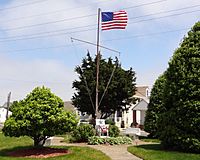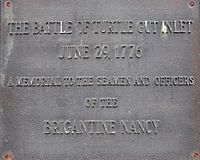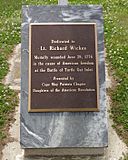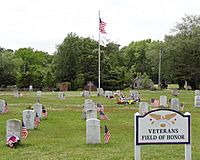Battle of Turtle Gut Inlet facts for kids
Quick facts for kids Battle of Turtle Gut Inlet |
|||||||
|---|---|---|---|---|---|---|---|
| Part of the American Revolutionary War | |||||||
 Location of Turtle Gut Inlet on 1777 map |
|||||||
|
|||||||
| Belligerents | |||||||
| Commanders and leaders | |||||||
| Charles Hudson Alexander Graeme |
John Barry Lambert Wickes William Hallock Hugh Montgomery |
||||||
| Strength | |||||||
| HMS Orpheus HMS Kingfisher |
USS Lexington USS Reprisal USS Wasp Nancy |
||||||
| Casualties and losses | |||||||
| Estimated 12–36 | Nancy destroyed Richard Wickes † |
||||||
The Battle of Turtle Gut Inlet was an important early naval victory for the Continental Navy. It happened on June 29, 1776. This battle involved Captain John Barry, who would later be called the "Father of the American Navy."
It was the first battle of the American Revolutionary War that involved a privateer ship. A privateer was a private ship allowed by the government to attack enemy ships. This battle also saw the first American soldier die in New Jersey during the war, Lieutenant Richard Wickes. He was the brother of Captain Lambert Wickes. This was the only Revolutionary War battle fought in Cape May County.
Why the Battle Happened

The British Navy wanted to stop Americans from getting war supplies. So, they blocked the Delaware Bay, which led to the important port of Philadelphia. This British fleet had over 240 cannons. To protect their river, Americans placed underwater obstacles called cheveaux-de-frise in the shipping channel.
To bring in gunpowder and weapons, Robert Morris hired a new ship called the brigantine Nancy. Her captain was Hugh Montgomery. This happened on March 1, 1776.
On March 14, 1776, John Barry became a captain in the Continental Navy. He commanded the ship Lexington, which had fourteen guns.
In early June, the privateer Nancy picked up supplies in the Caribbean islands of St. Thomas and St. Croix. She was carrying a lot of gunpowder, guns, rum, and sugar. She then sailed towards Philadelphia.
In mid-June, Robert Morris warned Captain Barry that Nancy was on her way. She needed protection because she only had an eleven-person crew and six cannons. Captain Barry soon met up with two other American ships. These were the Reprisal, led by Captain Lambert Wickes, and the Wasp, led by Captain William Hallock. They all headed for Cape May to help Nancy.
The British ships blocking the bay were led by the HMS Liverpool. Other British ships included the HMS Orpheus and the HMS Kingfisher.
How the Battle Unfolded
Late on June 28, a lookout on the British ship Kingfisher saw Nancy sailing near Cape May. The Kingfisher and Orpheus began to chase her. An American lookout at Cape May also spotted Nancy and the British ships.
Captain Barry, on Lexington, got a message from Nancy using flag signals. She needed help. Barry then signaled Reprisal and Wasp and met with their captains. They quickly made a plan. Small boats, called Longboats, from Lexington, Wasp, and Reprisal set out to help Nancy. Lieutenant Richard Wickes led these boats.
In the early morning of June 29, a heavy fog covered the area. The British ships Orpheus and Kingfisher were still chasing Nancy. Nancy could not enter Delaware Bay because of the British blockade. So, she headed for the nearby Turtle Gut Inlet. She soon ran aground, meaning she got stuck in shallow water. The larger British ships could not follow her into the shallow inlet.
The British ships started firing cannons at Nancy. They were still too far to hit her easily, but they were getting closer. The Americans tried to save the cargo, especially the gunpowder barrels. Captain Barry divided his crews into two groups. One group fired cannons back at the British to keep them from getting too close. The other group moved the cargo onto the small longboats. They rowed the cargo to shore, where local people helped unload it behind the sand dunes.
By late morning on June 29, the Americans had saved most of the gunpowder. They had moved 265 to 286 barrels. The British cannons had badly damaged Nancy. Captain Barry ordered his crew to make a long fuse. They wrapped the main sail around fifty pounds of gunpowder. This fuse ran from the nearly 100 gunpowder barrels still in the ship's hold, up to the deck, and over the side.
The fuse was lit as the crew left the ship. One last sailor climbed the mast to take down the American flag. The British thought the flag coming down meant Nancy was surrendering. They quickly boarded the ship. But by then, the fuse had reached the gunpowder in the hold. The gunpowder exploded with a huge blast that was felt for miles. Many British sailors were killed. Captain Graeme reported that his master's mate and six men from Kingfisher's longboats died.
Lieutenant Richard Wickes was killed by British cannon fire near the end of the battle. He was the brother of Captain Lambert Wickes.
What Happened After the Battle
This battle showed the British how clever and determined the American forces could be. Because of this, the British Navy moved their blockade of Philadelphia further away from the Cape May area.
Captain John Barry's brave actions were quickly noticed. He saved most of the gunpowder and drove off two Royal Navy ships. This was an important step in his career.
After the battle, Captain Wickes on Reprisal continued his mission to the West Indies.
Lieutenant Richard Wickes is buried at the Cold Spring Presbyterian Church cemetery. A part of the cemetery, called Veterans Field of Honor, honors his memory.
The seal of Wildwood Crest and the Wildwood Crest Historical Society both show a drawing of the brigantine Nancy. This is to remember the battle.
In 1922, Cape May County filled in Turtle Gut Inlet. Today, a small park marks the site of the battle.
Gallery
- Wildwood Crest
- Cold Spring Presbyterian Church cemetery






